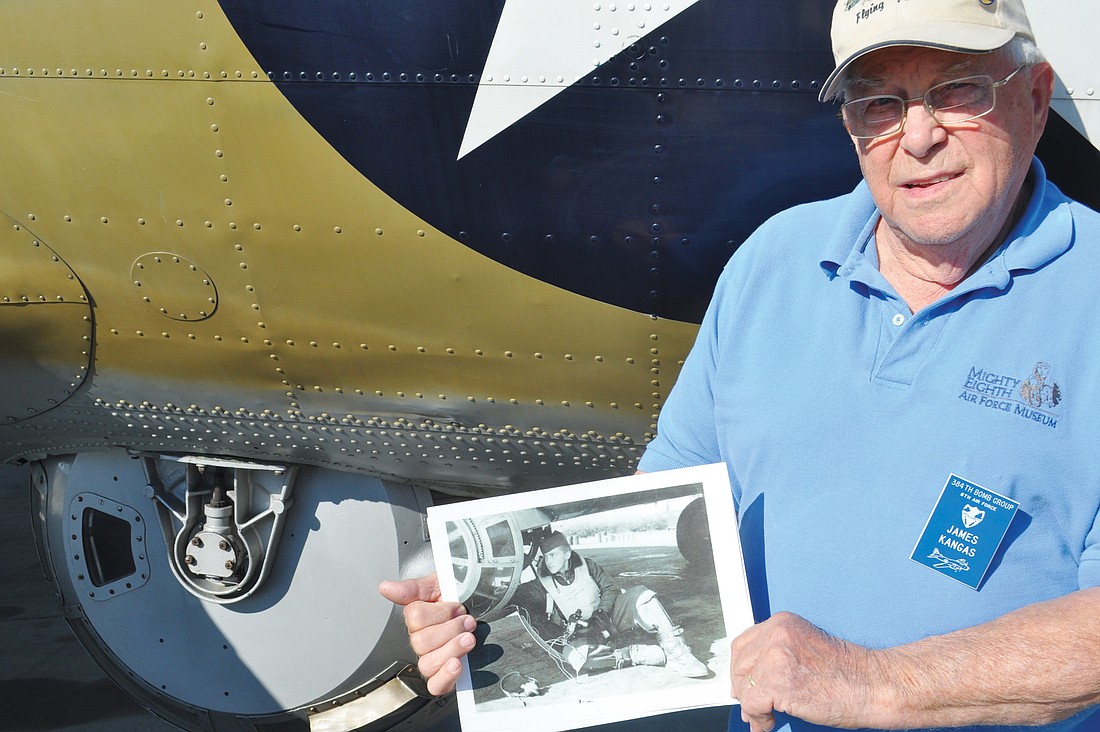- April 20, 2024
-
-
Loading

Loading

EAST COUNTY — James Kangas wrapped his 87-year-old fingers around the long metal barrel of the .50-caliber machine gun extending through the turret of a B-17 bomber.
Then, he pulled out a creaseless certificate from the Air Force, dated April 25, 1945 and addressed to “The Lucky Bastard Club,” an ode to Kangas’ injury-free 35-mission tour.
“No brothers got a scratch,” the paper read in inky black cursive.
Kangas, a World War II 8th Air Force veteran and former ball turret gunner on a B-17 bomber who usually shies away from reunions, became nostalgic Jan. 25, at the Sarasota-Bradenton International Airport as part of the Wings of Freedom Tour.
The tour, held Jan. 23 through Jan. 25, in Sarasota, is the only event in the world during which the public can fly on a B-17 bomber, B-24 bomber and a P-51 Mustang fighter.
The non-profit Collings Foundation, which seeks to support living-history events, annually tours the country with the planes.
While at the event, Kangas, an East County resident, shared war stories with Denny King and Dave Daily, fellow members of VFW Post 12055, in Lakewood Ranch,
Kangas joked he couldn’t fit his wide frame — much larger than his fighting days of 132 pounds on his 5-foot, 5-inch frame — into the plane now.
He also noticed the B-17’s turret had less glass than he remembered.
“It’s emotional to be here,” Kangas said. “It chokes you up thinking about old friends who are gone and reliving things to which you were exposed.”
Kangas, a veteran of 35 missions in Germany, who also spent time in England and Iceland, says he feels lost in large group get-togethers with veterans who fought in different places and at different times.
Sure, they all fought for the same cause, but Kangas experienced something others didn’t; he had a unique view formed from behind an oxygen mask in the belly of a B-17 plane.
Kangas developed the endurance to squeeze into the plane’s tiny turret for eight to 10 hours a day from his days growing up on a dairy farm in Minnesota, where he milked cows and hoed hay.
The youngest of five boys, Kangas watched his older brothers all participate in the armed services.
Kangas’ father, who worked in defense, knew the price of war.
When a 17-year-old Kangas tried to enlist in the Navy with a friend, his father wouldn’t sign the papers.
A year later, at 18, Kangas was drafted into the Air Force.
At gunnery school in Arizona, the Air Force told Kangas his small stature made him a perfect fit for the turret.
His two-year military career soon began.
Always the smallest on his crew, Kangas sat on a wooden seat in the turret with his back and head against the padded door, his legs held in mid-air by two footrests on the front wall.
Behind an oxygen mask required by high-altitude flying, Kangas’ eyes met a pair of .50-caliber machine guns that extended through the turret on both sides of him.
Kangas’ hands, hidden beneath a full body electric suit and gloves wired for warmth to fight below-zero temperatures, controlled the guns and fired bullets through two handgrips with buttons.
The tight, closed-off space left Kangas lonely and vulnerable — it was hardest for him to exit the plane in the event of an emergency.
But it also offered freedom.
Kangas would cheat and slip milk chocolate Hershey bars under his mask.
He needed all the boost he could get to weather the tough times.
On one mission in December 1944, a sleet storm in England clogged the propellers of Kangas’ B-17, a brand-new plane.
The propellers couldn’t churn fast enough.
The plane’s captain yelled, “Bailout!”
Kangas could barely hear the command as ice flicked off the plane’s propellers.
Kangas heard enough and slid out of the turret, kicking off the side door before parachuting from the plane, less than 1,000 feet from the ground.
Sleet stones nipped on Kangas’ parachute.
It sounded like chickens pecking on feed back at the farm.
Floating with the breeze, Kangas drifted into a thick cloud, where it became deadly quiet.
A whiplash left him briefly unconscious. He didn’t know if he was dead or alive.
He awoke and floated lower until he could see a man scraping ice off the windshield of his truck.
He yelled at the man.
“He looked everywhere but up,” Kangas said.
Kangas landed far from the truck. He walked a half-mile, by old English houses with straw roofs and stone buildings.
Nearby, Kangas located a crewmember, and the two were able to call Air Force controllers who sent a truck to rescue them.
Kangas — as in all his missions — was unharmed.
Two crewmembers had broken their legs in the bailout.
Another mission, the last of the 8th Air Force, left Kangas’ plane without two engines. On a flight in April 1945 from England to Pilsen, Czechoslovakia, German anti-aircraft shot at the B-17’s engines.
From the plane’s belly, Kangas could see the red flash of the explosion.
The hole-filled plane managed to land safely in Belgium, allied territory.
“If it’s your time, it’s your time,” Kangas said of his wartime experience. “You don’t have much control.”
Kangas’ brief tour left him fearless and confident.
In 1945, after his service, he went to Detroit to attend night school for engineering before settling in Minnesota where he worked as a carpenter contractor.
He retired two years ago to Bradenton.
At the end of the Wings of Freedom Tour, the Collings Foundation gave Kangas an honor flight to Venice aboard the B-17.
Although Kangas has no physical wounds, his experiences have left an imprint on him.
“I’m glad I served and I’m glad I got out,” Kangas said. “I figure I’m damn lucky.”
Contact Josh Siegel at [email protected].